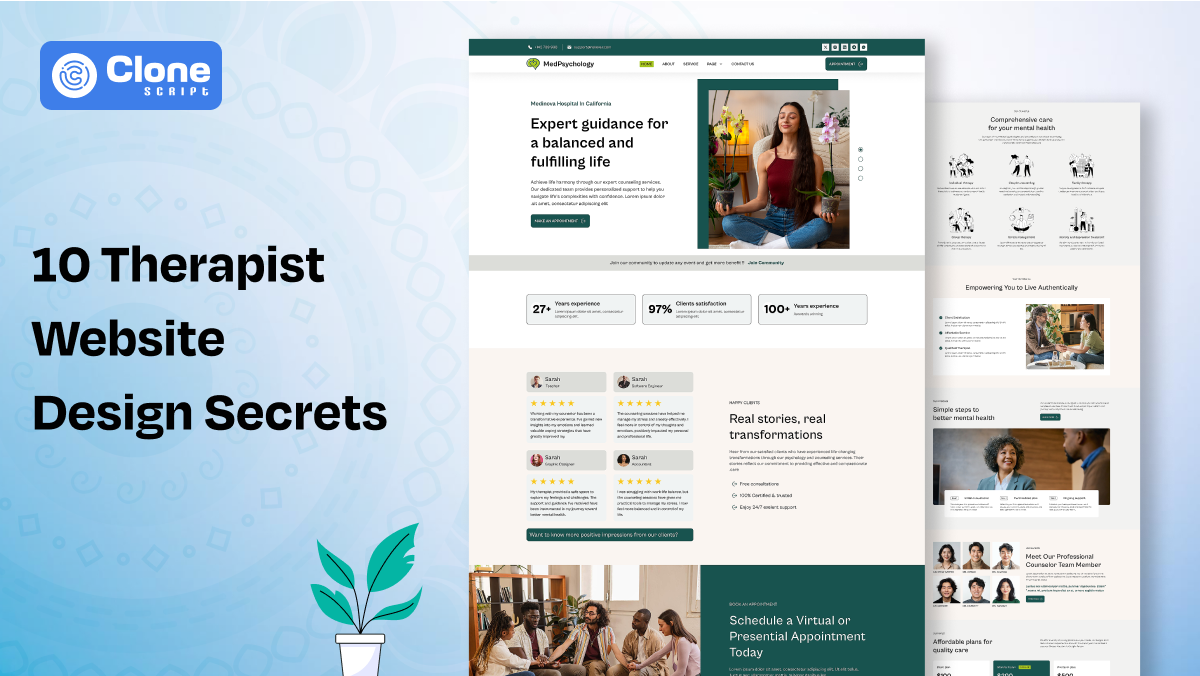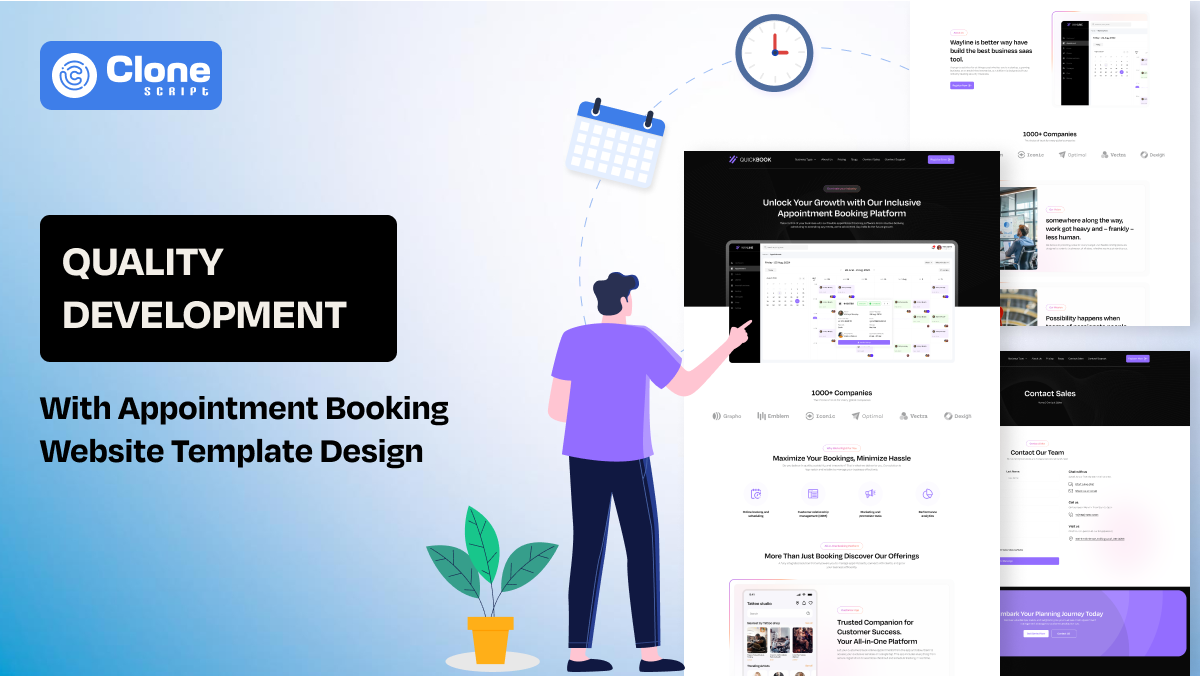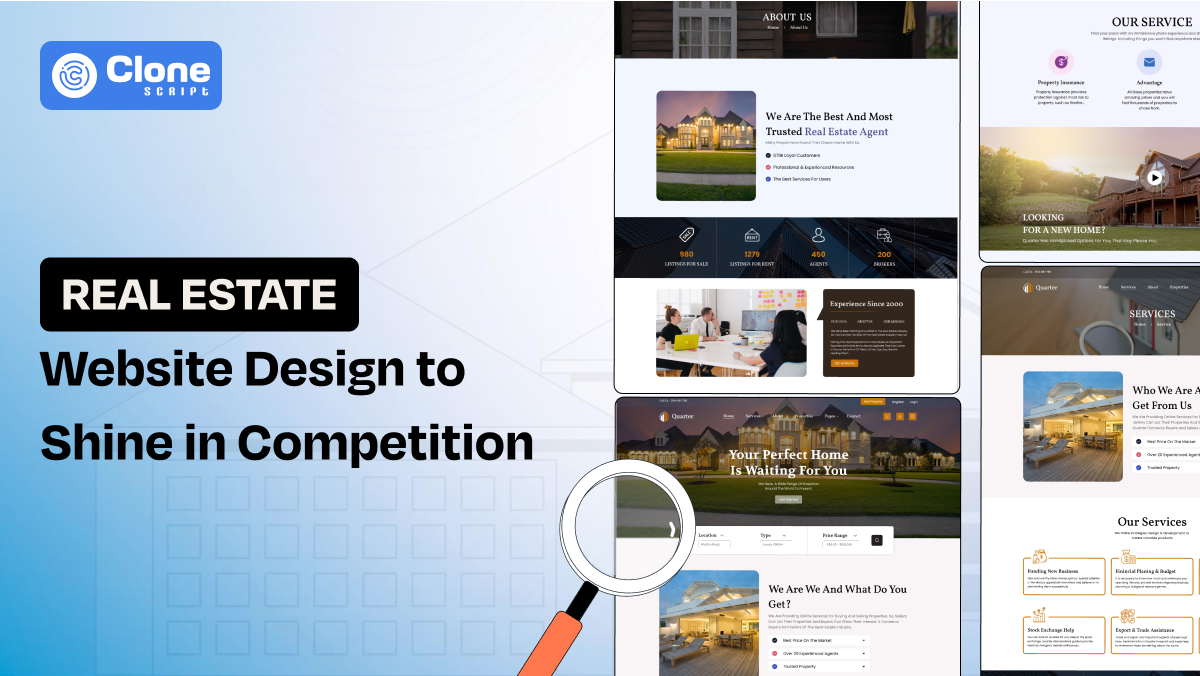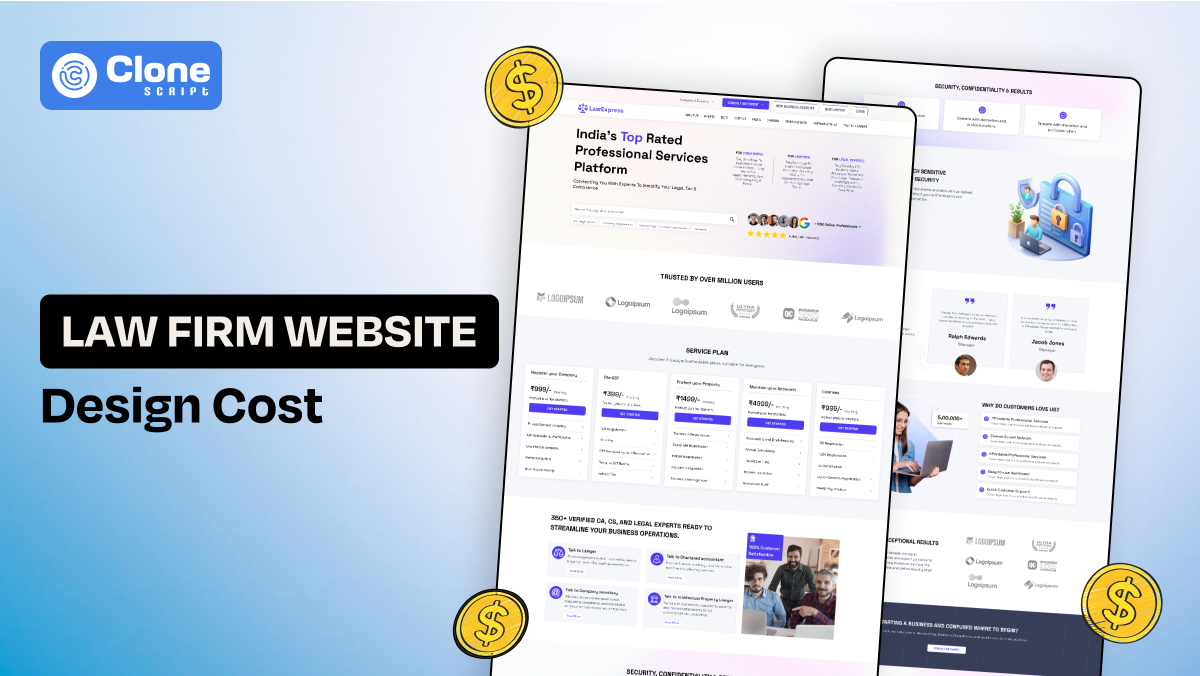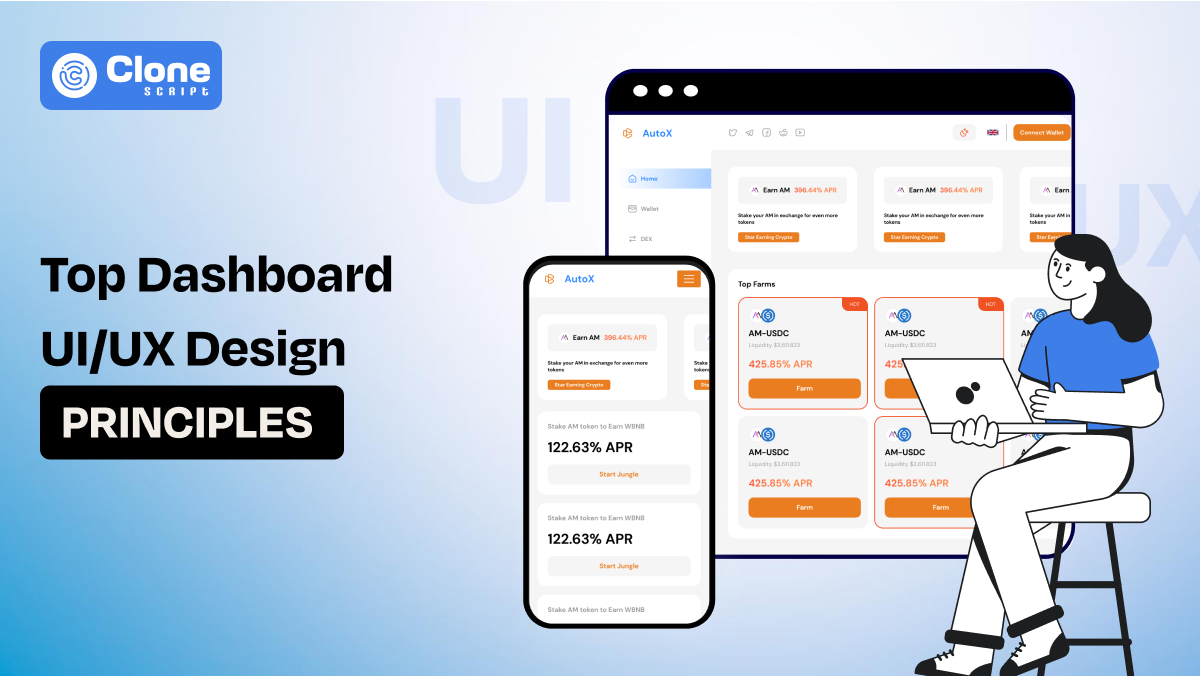10 Therapist Website Design Secrets: Convert Visitors into Valued Patients
When someone searches for a therapist, they’re not just looking for information. They’re seeking trust, safety, and the promise of healing. That makes your psychotherapy website one of your most important tools. It's more than a digital business card. It’s a gateway to connection. And the right design can mean the difference between a passing visitor and a loyal patient.
At our web design company, we’ve spent years crafting website UI design kits, specifically for therapists, counselors, and mental health professionals. What we’ve learned is that small design details have a massive impact on engagement and conversions. Whether you're an independent therapist, running a group practice, or building a mental wellness brand, your site design matters.
Here are 10 therapist website design secrets that will help you convert more visitors into valued patients.
Remember: You don’t have to open Figma and try to DIY design the website. This article is helpful to understand when you hire a web UI designer for a therapist's website design. So, already you know the important things, the site looks professional, and you need the changes in design, you can recommend changes to the designers.
Create a Calming, Trust-Building First Impression.
The moment a potential patient lands on your homepage, their first emotional impression will determine whether they stay or leave. For therapists, that emotion must be one of calm and trust.
-
A clean layout with generous white space, soft color palettes (like sage green, pastel blue, or warm neutrals), and natural imagery (such as peaceful landscapes or cozy spaces) communicates safety.
-
Avoid cluttered interfaces, harsh colors, or corporate-style visuals. They’re more likely to repel than reassure.
In other words, a landing page design should convey the messages you want to say to your patient (patient). Once they find the professionalism and minimal efforts to reach you, they’re most like to book a therapy consultation online. Why? Because your first impression on the top.
Real Impact: A therapist site with a soothing, thoughtful aesthetic increases dwell time and builds subconscious trust before a word is read.
Make Your Value Statement Immediately Visible.
Your hero section (the top part of your homepage) should clearly answer two questions:
-
Who do you help?
-
How do you help them?
Instead of a vague phrase like “Welcome to My Practice,” try:
“Helping adults navigate anxiety, trauma, and burnout with evidence-based therapy in a supportive space.”
This concise value proposition lets visitors know they’ve come to the right place, and it sets your practice apart.
We recommend that you hire a professional web copywriter instead of doing it yourself. They will put the word in the right place and increase the chances for consultation sessions for therapy.
Design Tip: Use large, legible fonts (Google Fonts) and a high-contrast background. A supporting call-to-action (CTA) button like “Book a Free Consultation” should appear without scrolling.
Prioritize Easy Navigation Throughout the Website Development.
In a therapy website development, one thing always has the best chance to hold the attention: easy navigation.
Look, patients are already suffering from the psychological effects, and they don’t want to reach by clicking every page 10 times. They hate confusing layouts and miscommunications.
Keep your navigation bar minimal, ideally no more than 5-6 main items:
-
Home
-
About
-
Services
-
FAQs
-
Blog (optional)
-
Contact
Avoid dropdown menus with multiple layers. Every page should be reachable within two clicks. And make sure your contact button is always visible, whether in a sticky header or footer.
Why It Works: Clean navigation reduces bounce rates and increases page-to-page movement, helping users explore your offerings with less time.
Showcase Professional Yet Warm Bio Sections.
Many therapist websites fail to convey personality, sounding either too clinical or too casual. Keep the balance by designing an “About Me” page that combines professional experience with personal connection.
Visually, use a high-resolution headshot in a natural environment (not a stiff office background). Add pull quotes or short blurbs next to images:
“My approach is rooted in compassion, empathy, and over a decade of therapeutic experience.”
Make sure it’s skimmable, with headers like:
-
My Therapy Style
-
My Credentials
-
Why I Became a Therapist
Conversion Benefit: Visitors connect emotionally with your story, building trust before scheduling an appointment.
Design Service Pages That Speak to Pain Points.
Instead of generic service pages that list therapy types, build the design around user pain points and outcomes. Each service page (e.g., Anxiety Therapy, Couples Counseling, Teen Therapy) should answer:
-
What challenges does this solve?
-
What will patients feel after working with you?
Use soft icons, brief subheadings, and bulleted outcomes:
-
Rebuild confidence after trauma
-
Navigate life transitions with clarity
-
Improve communication with your partner
Add photos or illustrations that reflect your audience. Do not add stocky, staged images.
Why This Works: Pain point-driven design shows empathy, positioning you as a guide in their healing journey.
Integrate a Simple and Friendly Booking System.
Your goal is to remove all obstacles to scheduling. A well-integrated booking feature on the website is not just a convenience. It’s a conversion strategy.
Instead of a static contact form, use a real-time calendar plugin (like Calendly or SimplePractice integration) where users can:
-
Pick a date
-
Choose a service (consultation, 1:1 therapy, etc.)
-
Confirm via email/SMS
Keep the interface clean, with plenty of white space and large click targets. Reassure users with microcopy like:
“Your information is secure. No credit card required to book.”
Conversion Advantage: Self-scheduling encourages hesitant users to take the first step, especially during off-hours when they can’t call. Also, handling a small number of patients will not require any CRM tools for email marketing, especially if you have a local clinic.
Include Testimonials and Social Proof Strategically.
Patient testimonials are one of the strongest trust signals, but it’s placement and format matter.
Just think a patient wants to book trauma therapy at your clinic, but there is no feedback regarding your service. So, ask yourself: Will he book the session with you? Probably not.
Don’t crowd testimonials into one long block of text. Instead, use sliders, quote boxes, or even brief video clips. Space them out across the site:
-
One on the homepage
-
One on the About page
-
One at the bottom of the service pages
You can also include third-party endorsements (e.g., Psychology Today profiles, verified practice licenses, community awards).
Why This Works: Social proof presented in a minimal, eye-catching way feels more authentic and less “salesy.”
Ensure Mobile Responsiveness with Thoughtful Layouts.
Most of the patients want to book a therapy session through smartphones. The website has to be optimized for a mobile-responsive design to get listed on your list.
In addition, website speed optimization is a key element to not lose the booking sessions due to a poor user experience.
Design-specific tips:
-
Large, tappable buttons (avoid crammed links)
-
No walls of text. Use accordions or collapsible sections for FAQs
-
Avoid pop-ups or fixed elements that block scrolling
Visual Flow: Stack content vertically with generous padding. Always test your contact forms, calendar, and CTAs on multiple device sizes.
Why It Matters: A poorly designed mobile experience can drive away patients instantly. Responsive design increases trust, especially for on-the-go users seeking immediate support.
Use Visual Anchors and Soft Animation.
Don’t underestimate the power of tiny design motion. Soft transitions, hover effects, and animated visual anchors help guide visitors' eyes and keep them engaged.
Examples of animation effects in psychotherapy website design:
-
Fade-in effect for testimonials
-
Soft underline on hovered navigation
-
Gentle slide for form entry fields
Avoid gimmicky animation. The goal is to reinforce calm, flow, and intentional browsing.
Also, incorporate visual anchors like:
-
Section dividers with icons
-
Soft gradient overlays
-
Horizontal rules to separate thoughts
What It Does: This creates a smooth reading experience that mirrors therapeutic calm, encouraging users to explore the website longer.
Add Educational Content to Establish Authority.
Only having the best therapy website design in the market is not enough until you don’t establish yourself as an expert therapist.
But how can you do that?
A well-designed blog or resource section helps position you as an expert. But avoid walls of text.
Each article should feature:
-
A clear, minimalist layout with headers
-
Thoughtful visuals (not just filler images)
-
A CTA at the end, like “Interested in learning more about trauma recovery therapy? Let’s talk.”
Even a downloadable PDF (e.g., “5 Signs of Burnout”) or short video Q&A can reinforce your credibility and give value to new visitors.
It’s better to take skilled blog writing and article writing services from reputable sources. They will manage the entire content on the web and help you to drive a successful therapy consultation and healing services.
Why It Helps: Educational design builds trust over time, especially for patients not ready to book yet but open to talk.
Conclusion
A therapist's website isn’t just a business tool. It’s a digital extension of your therapeutic presence. How your site looks, flows, and communicates directly impacts how safe, seen, and understood your visitors feel. These small design decisions from layout to typography to booking flow are not just cosmetic. They’re psychological.
By investing in the right UI design principles, you help reduce frustration, build trust, and ultimately, convert casual visitors into valued patients who believe you’re the right person to help them heal.
If you’re ready to create a website that works for you 24/7, even while you're in session, our team is here to help you design something not just beautiful, but therapeutically effective.
Contact us now. We’re on a mission to make your virtual clinic more professional and accessible. Whether you just need to see the MVP of your therapy website or a live platform for your service, we’re here to offer our expertise. Just let us know what your goals you want to achieve, and the rest of us will handle it proactively.
FAQs
-
By purchasing only the website UI design kit, will my therapy website be live?
No. The UI kits are only a kind of MVP that helps you visualize how the website will look when it goes live. To make it available on the web for your patients, you have to invest in frontend development and backend development.
-
How much does it cost to develop a therapy website?
The total cost of therapy website development ranges between $1000 to $2500. The cost includes a website UI/UX design, front and backend development, domain hosting, server management, payment gateway integration, etc. Also, the features you want in the website hike the price by 20-30% overall.
-
Can a website template be useful for web development?
Yes, a website template is the best and quickest way to speed up web development efforts. By choosing a psychotherapy website template, you can have the advantage of using pre-built UI elements and HTML layouts. So, it’s a good initiative for you to get an affordable website development.
 BTC - Bitcoin
BTC - Bitcoin
 USDTERC20 - USDT ERC20
USDTERC20 - USDT ERC20
 ETH - Ethereum
ETH - Ethereum
 BNB - Binance
BNB - Binance
 BCH - Bitcoin Cash
BCH - Bitcoin Cash
 DOGE - Dogecoin
DOGE - Dogecoin
 TRX - TRON
TRX - TRON
 USDTTRC20 - USD TRC20
USDTTRC20 - USD TRC20
 LTC - LiteCoin
LTC - LiteCoin

